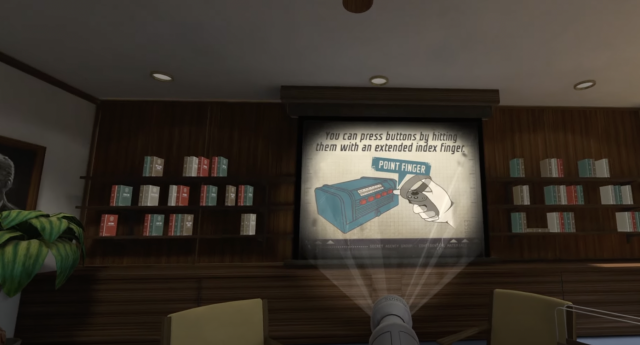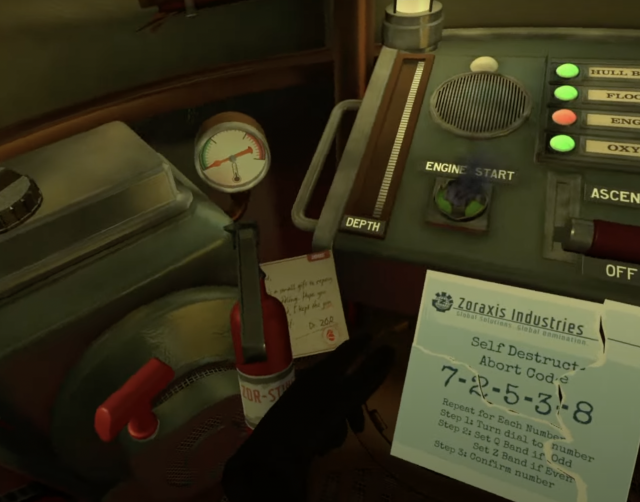What is it about?
I Expect You To Die is a VR escape room-style puzzle game developed by Schell Games. The player plays the role of a secret agent and engages in missions such as escaping death situations and stopping evil plans of world domination. In each mission, the player is thrown into a puzzle box, and is required to use whatever that is available around them as well as their problem-solving skills to clear the mission.
What makes it engaging?
I Expect You To Die simulates a real-life escape room environment, with the player’s point-of-view changes according to the player’s postures, such as bending down and turning around. The usual text comments are also replaced by a humorous voice, which contributes to the immersive environment.
Another detail worth noting is that the player’s hand gets hidden when grabbing any item, which prevents the problem of hand model intersecting with the item during grabbing. While some research has shown that a non-disappearing hand during grabbing improves the immersive experience by increasing the ownership of the player [1], it is hard to notice that the hand disappears during the actual game play, therefore does not hinder with the immersive experience in practice.
Apart from the immersive VR environment, this game also provides players with great freedom in interacting with the items and the environment. Unlike traditional escape room games, this game also encourages creativity by allowing more than one way to complete each mission – just like how problems can be solved in the real world.
What features are well done?
Firstly, time limits are implemented when certain conditions are triggered, for example when a dynamite is being lit. This allows game over to happen frequently – something too costly for a real-life escape room to implement. It is also part of the experience for the player to watch things going wrong in different ways, as there is great freedom in the different actions that players choose to take under pressure situations.
Secondly, this game uses hand-controller buttons to achieve telekinesis, and the player solves all the puzzles in stationary, without having to teleport or move away from the initial position. While it may seem restrictive, it allows the player to focus on the puzzle solving, and also reduces risks of VR sickness from locomotion [2].
Last but not least, this application implemented well-designed onboarding tutorials for the player to try out and practice each gameplay action before embarking on each mission stage. This is an important plus point especially for VR games, where there may be players who are unfamiliar with using the VR hand controllers.

What can be improved?
In traditional puzzle games played on PC or mobile devices, usable items are usually kept in the inventory and items have indications of whether they can be assembled. In this game, there is no visual hints showing how to use the items or whether they are correctly used, which simulates the difficulty of escaping in a real-life setting. However, I do think that for minor puzzles, such as piecing torn documents together, there can be visual checkpoints to indicate completion.
Next, there can be more continuity in the storyline of the game. The current game connects the mission stages only via an agent room for mission release. There can be better character and story development across the stages.
In addition, puzzles involving NPCs can be introduced to provide more possible ways of interaction. In appropriate storylines, this can further heighten the tense or horrific atmosphere the player experiences.
Finally, as a puzzle game, a question to consider is retaining players after all stages are cleared. A potential enhancement is to introduce multiplayer features, for example allowing other player to sabotage during each mission stage.

Conclusion
In general, I Expect You To Die is an engaging escape room-style puzzle game that is worth trying out, and has the potential of expanding to a significant VR game series.
[1] A. Adkins, L. Lin, A. Normoyle, R. Canales, Y. Ye, and S. Jörg, “Evaluating grasping visualizations and control modes in a VR game,” ACM Transactions on Applied Perception, vol. 18, no. 4, pp. 1–14, 2021.
[2] D. Saredakis, A. Szpak, B. Birckhead, H. A. Keage, A. Rizzo, and T. Loetscher, “Factors associated with virtual reality sickness in head-mounted displays: A systematic review and meta-analysis,” Frontiers in Human Neuroscience, vol. 14, 2020.
